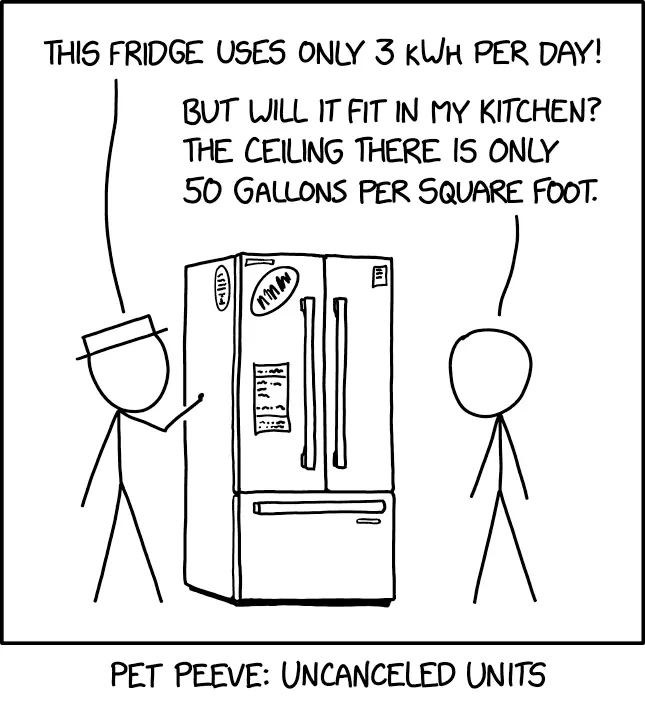Edit: Alt Text: Speed limit c arcminutes^2 per steradian.
There’s nothing wrong with kilowatts, it’s an SI unit. The problem is hour, which is 3600 seconds, and we have ancient Egyptians to blame for this, who divided the day into 24 hours despite having already developed base-10 numerical system.
Kilowatt per kilosecond, which is 1 megajoule, would work better.
My car needs 0.07 square millimeters of fuel on the highway.
kWh is already an uncanceled unit, drives me nuts even without adding per day
(Energy / time) * time? fuck you
It’s because the times aren’t the same. Maybe same unit but different context so they can’t be canceled.
It’s like saying you work 8 Hours/day (Eight hours per day). Both are units of time, but their context is different and their combination forms a new meaning beyond the units.
1 KWh is using 1KW for one hour. Because of demand pricing the time you use that KW is important. Like in terms of energy grid using a whole ton of power for one minute vs same total over a long time is different and important dispite being the same amount of energy.
Edit: some phrasing
Good point, and agreed that thinking in kWh is very intuitive and convenient in some contexts like household appliances, but it’s being used as a more general unit for energy while Joules are just so much better at, well, representing energy and being able to transition from electric to thermal etc.
I know why but it’s stupid and arbitrary and the arbitraryness is what’s forcing it.
It’s the time. It’s always the time.
SI units are all derived from seconds but instead of working with kiloseconds we have minutes and hours and days with a bunch of idiotic conversions.
The “second” you invite time into your measure, you invite some real bullshit ad-hoc pseudo-unit convenience units and fuck them. May as well just go imperial and have 14 rods to the fucking hogshead.
Because nobody’s used to seeing Joules, you could swap in kJ for kW-seconds but then you probably need to switch base (MJh) to keep it practical, and now people need to do extra math to tell what will be on their power bill
But go ahead and call your power company to get them to list Joules
My power company provides me electricity in kWh, and heating (in the form of hot water) in GJ. And my cold water gets charged in m3.
So they DO know. For a few years, they’d even “helpfully” translate the GJ into kWh, untill it started to piss off people who bought electric heaters and found that those two numbers weren’t actually the same in the real world.
My power company DOES tell me in Joules, but only for gas so that’s already bullshit, and I live in Alberta so people already can’t decipher their fucking power bill’s opaque energy/distribution fee/transmission fee costs so that’s bullshit too
It’s also due to social inertia.
Power companies charge by the kWh because their generators are measured in total output wattage and consumers consume at different wattages at different times.
Sure, it would be easier to measure in total joules consumed per period time but it would also be easier to measure with world standard metric units. The pain of changing is harder than staying the same, so muh freedum units.
It gets even better when you read about annual or even daily energy production of a specific power plant.
For example, the annual production of Aswan dam in Egypt is about 10 042 GWh, which translates to an average power output of about 1.1 GW. Now that you have this number, you can compare that with the maximum theoretical power output which is 2.1 GW. Therefore, they should have plenty of capacity left, but you can’t tell that just by looking at the published numbers. They just have to use convoluted units, because that’s the tradition in a bunch of industries.
I need the alt text!
Sorry! I added it now.
First of all, thanks for posting new threads here, it was getting somewhat dull that I was in recent weeks always the first one, sometimes after several days.
You might want to post comics the same way I did: https://discuss.tchncs.de/post/28278776 i.e. not just with the alt text, but also with a link to explainxkcd. You can easily copy the alt text if you switch to m.xkcd.com.
For something that doesn’t run continuously, like eg. a refrigerator, then an average daily usage is more useful, no? “This product draws 1.5 kW with a duty cycle of 0.08” doesn’t really help when comparing efficiencies of potential purchases, you’d need to convert it to electricity consumed in a set period anyway.
No, it’s because watts are joules per second, so kWh are (energy / time) * time. Cancelling the units would be expressing the energy directly in joules.
Exactly, it’s a unit of convenience, not a unit of abstract precision.
Even a unit of “gallons/sqft” could be handy in the right context. If you were trying to design a storage solution for discretely packaged product for example, it could be a figure of merit despite literally factoring out to a unit of length.
I could imagine a scenario where gal/ft² is useful. Like with grocery store shelving figuring shelving and product stacking. If liquid storage containers are stackable then you have have more gallons per square footage of shelf space. Or of they’re not stackable, then taller containers would hold more liquid in the same shelf space than shorter containers with the same footprint.
Yeah it seems odd to represent something as a volume/area, but that is the relevant information you’re comparing and it’s intuitive how that number changes based on changes to volume as projected onto an area. Bigger number points toward a more efficient use of shelving.
I can’t imagine why kWh would be more convenient than MJ though.
Because people have an intuitive feeling about how much 1 kW is, because they use devices with a power rating in Watt and have a feel for how powerful a device is at what rating. People also know exactly what an hour is. So it makes sense to think about a device of 1kW running for 1 hour, people have a good sense of how much energy that is in daily use. Since most energy bills are also in terms of kWh, people also have a good sense about the costs of that energy.
Given the popularity of the unit, I think people like it, otherwise a different unit would have been used already.
Because the power draw of appliances is measured in watts, so a 60 watt light bulb when lit draws 60 watts of power over the course of one hour. So if I have roughly 100 lightbulbs at 60 watts hooked up to my house, then I’ll be using 6 kW of power each hour.
It tells us more information about the rate of use of that energy. It’s like the difference between a 2 lb sphere of uranium being exploded in a fraction of a second vs 2 lb lf uranium fuel in a reactor operating for however long that much fuel lasts for. Both contain the same amount of joules of energy at the end of the process, one just uses all of those joules in one go and the other slowly releases that energy over a longer period of time.
You could also list some long term average power draw instead of the peak.
That’s 203.7cm for anyone wondering
6’8” in Murica units.








